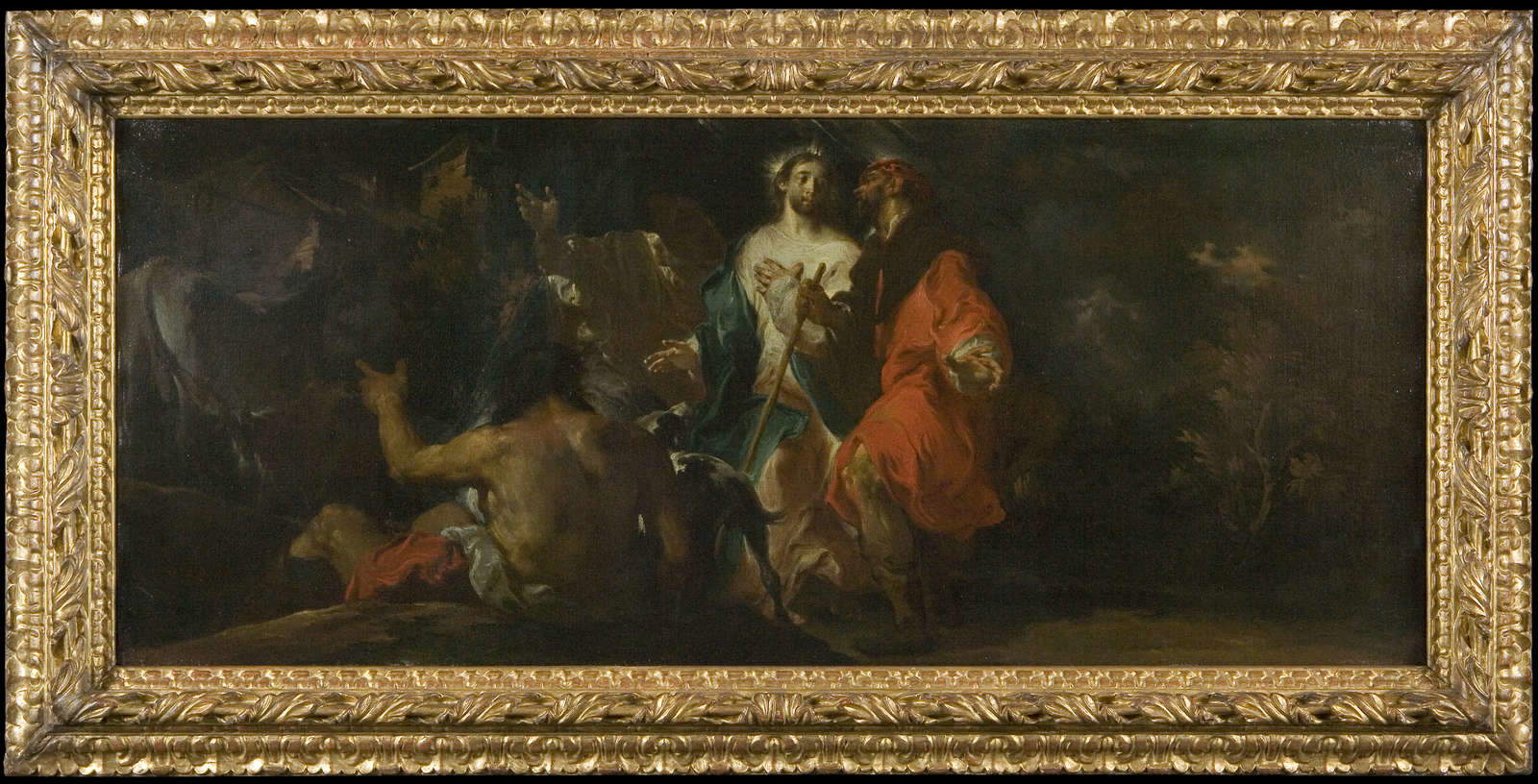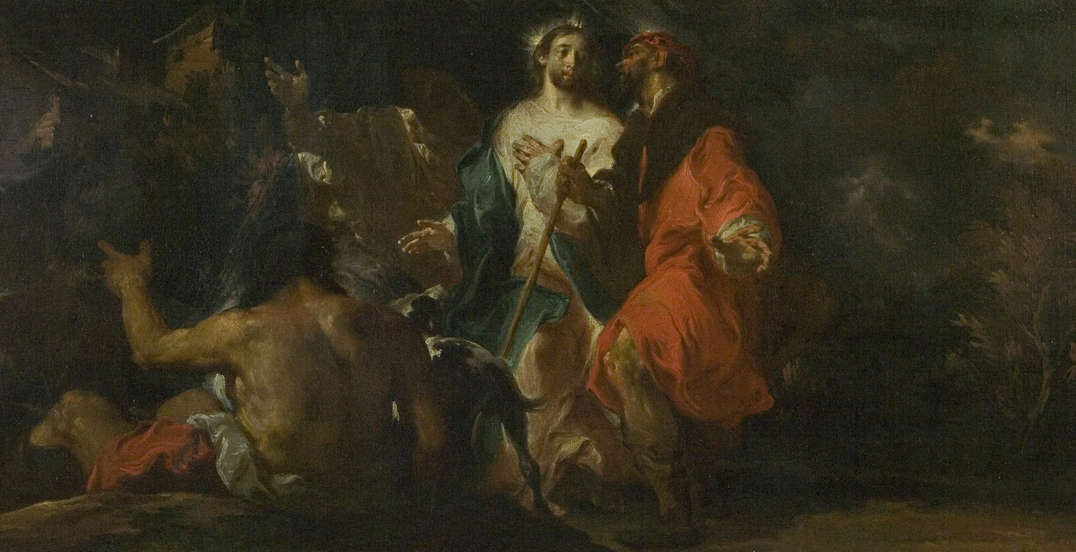In Mantua, the Ducal Palace goes wild on the market: after acquiring and presenting within a few weeks the Crucifixion by the Master of San Vincenzo Martire (a work that could help unravel the identity of the anonymous painter) and theAdoration of the Shepherds by Girolamo Bonsignori, a masterpiece by the Venetian painter, theinstitute enriches its collection with a major new work, Christ and the Pilgrims on the Road to Emmaus, an early masterpiece by Giuseppe Bazzani (Mantua, 1690 - 1769), a key figure in 18th-century painting in Mantua. The acquisition of the painting, which depicts one of Christ’s first encounters after the resurrection, is of importance not only for its artistic quality but also for the fundamental contribution it makes to the reconstruction of the master’s career.
The work, created around 1720-1725, in fact represents one of the rare examples of the early production of Bazzani, who was born in 1690 and was active in the workshop from a young age. Thanks to this painting, it will be possible to learn more about the training and stylistic evolution of the painter, who is renowned for the expressive delicacy and emotional depth that shine through his works.
“The painting augments the permanent collections of the Ducal Palace Museum,” says the director of the Ducal Palace in Mantua Stefano L’Occaso, “and thanks go to the Mossini Gallery in Mantua. I am proud of the acquisition, because-in Bazzani’s extensive catalog-this work plays an important, special, almost unique role. The other sincere thanks go to Professor Massimo Osanna, director general of the Ministry of Culture, his entire staff and the Technical Scientific Committee, which, once again, accepted a proposal from the Ducal Palace: we have been engaged in a constant campaign of acquisitions since 2020, punctually supported by the Ministry.”
“The Ducal Palace Museum,” emphasizes Massimo Osanna, Director General of Museums, "is carrying out a series of recoveries of artistic heritage to which the Directorate General of Museums is pleased to contribute. In just a few years, not only have Giulio Romano’s tapestry with Filostrato’s ’Heroes’ and the precious Allegory of the Gonzaga Nevers family by the Genoese Grechetto been acquired, but also Gonzaga portraits, including the Coronation Portrait of Duke Vincent I, have returned to the museum. These recoveries are the significant outcome of the policy of enrichment of the museum’s permanent collections and, in general, of the national cultural heritage: the increased exhibition offer, focused on the historical role of the Gonzagas, also corresponds to new possibilities of study and research for the scientific community."

The recent acquisition of Christ and the Pilgrims on the Road to Emaus is part of a complex historical and artistic context that still raises questions about the early phase of Giuseppe Bazzani’s career. Although his earliest work dated with certainty is the San Luigi altarpiece in the Borgoforte church, dated 1729, this new painting anticipates that date by almost a decade, helping to clarify that the painter was already fully operational and mature in the years 1720-1725.
The discovery has extremely relevant value for the understanding of Bazzani’s artistic career, an author who, according to some scholars, would have taken up painting at an advanced age, perhaps after employment as an “art expert.” This thesis, argued by Flavio Caroli, has attracted criticism, as it seems implausible that an artist of such extraordinary expertise could have begun his career as a self-taught or amateur. On the contrary, it is likely that Bazzani was already in the workshop in 1705 and operationally autonomous around 1710, in line with the usual training path of artists of the time.
The question of the chronology of Giuseppe Bazzani’s works has long been a challenge for scholars. Although the catalog of the works has been carefully constructed thanks to the work of experts such as Nino Giannantoni, Nicola Ivanoff, Chiara Tellini Perina and, more recently, Flavio Caroli, the chronological arrangement of the works remains a complex knot. The acquired work thus represents an essential reference point for delineating the painter’s production in the early years of his activity.
The painting, mentioned in the inventory of notary Domizio Zampolli’s collection in 1727 as part of a pair of canvases, was located together with another work by Bazzani, Christ in the House of Magdalene, now housed at the Harvard Art Museum in Cambridge. The two paintings, once companions, were separated in the second half of the twentieth century when Christ in the House of Magdalene became part of the American collection. This division, although painful for artistic enjoyment, is now compensated for by the work’s return to Mantua, where the public can admire it in all its intensity.
The story of Christ and the Pilgrims on the Road to Emmaus has been marked by a long journey: the work has recently re-emerged thanks to the mediation of Galleria Mossini and the intervention of the General Directorate of Museums in Rome. This new acquisition by the Ducal Palace testifies to an ongoing commitment to the recovery and enhancement of works that represent local and national artistic heritage.
The 1727 inventory confirms the existence of Christ and the Pilgrims on the Road to Emmaus as early as the first decades of the 18th century, making it a valuable element in delineating Bazzani’s early maturity. The painting is not only a historical document, but a work that conveys the painter’s own expressiveness and humanity. Bazzani was a master at interpreting religious subjects with depth and introspection, making his works iconic for the eighteenth-century Mantua and for sacred painting in general at the time.
The painting depicts a highly symbolic moment: Christ appears to the pilgrims on the road to the village of Emmaus, an event narrated in the Gospel of Luke, illustrating one of the first encounters of the risen Jesus with his disciples. Bazzani’s skill lies in his ability to depict not only the physical encounter, but also the spirituality and feeling of surprise and awe that characterize the scene. The gazes of the pilgrims reveal deep emotional participation and create a visual connection that guides the viewer through the meaning of the miracle of the resurrection.
The painting is executed with a warm color palette and soft light, enveloping the figures in an intimate and meditative atmosphere. This technique was distinctive to Bazzani, who was known for his skillful use of color and light to create works full of pathos. The scene takes place in an almost suspended environment, where the divine is naturally intertwined with the everyday, an element that makes Bazzani’s works so accessible and touching to the public.
The acquisition of Christ and the Pilgrims on the Road to Emaus at the Doge’s Palace is not only an enrichment for Mantua’s collections, but represents a unique opportunity to explore the youth of one of the most highly regarded painters of the Italian 18th century. This masterpiece offers scholars and the public a more complete view of Bazzani’s talent, confirming how the Mantuan master was already endowed at a young age with an uncommon artistic sensitivity and technical mastery.
The Palazzo Ducale itinerary will thus allow visitors to embark on a journey through eighteenth-century Mantua, a time when the city continued to be a fervent cultural center. Through Christ and the Pilgrims on the Road to Emmaus, the emotional and spiritual world of Giuseppe Bazzani, one of Mantua’s greatest painters, is thus revealed.
 |
| Mantua, Ducal Palace unleashed on the market: an early masterpiece by Giuseppe Bazzani arrives |
Warning: the translation into English of the original Italian article was created using automatic tools. We undertake to review all articles, but we do not guarantee the total absence of inaccuracies in the translation due to the program. You can find the original by clicking on the ITA button. If you find any mistake,please contact us.